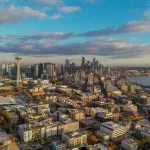Where to holiday when the world ends
Fast forward four decades later, and despite documented climate transformations and a proliferation of natural disasters, humanity’s approach is… shock, denial and mutterings of “it’ll never happen!” Who said things never change?
As we rapidly approach spewing out the trillionth tonne of CO2 into the atmosphere – the ‘carbon cut-off point’ – we’ll reach a moment where temperatures will rise by 2⁰C, enough to melt the ice caps and submerge coastlines under water. That means bucket list destinations such as the Great Barrier Reef, Florida and Venice will have kicked the proverbial bucket.
Now, in keeping with humanity’s ‘glass half full’ approach to global, extinction-level events, help is at hand. Travelplanners’ in-house futurology department has compiled a guide to the key tourist hotspots (no pun intended) of the future – just remember your Factor 1000.

The Great Pacific Trash Vortex
Unfortunately, millionaire’s playground Dubai – one of the richest global cities – is at risk. When the sea eventually rises by three metres, this metropolis and its man-made satellite isles, the Palm Islands, will succumb to the water.
Luckily, the human race produces 20,000 plastic bottles every second, and only 7% of these get recycled. This means we’re dumping millions of tonnes of plastic into the sea, and research shows we’ve already, accidently, created a Palm Islands replacement.
The Great Pacific Trash Vortex is an indeterminate mass of plastic, chemical sludge, and other floating debris. Unlike the Palm Islands, the Pacific Trash Vortex is completely climate change proof – and more importantly, immune to the forces of nature.
The Palm Islands will offer a unique experience. Like Waterworld but with added putrid stench. Instead of luxury apartments on sun-baked beaches, think plastic hovels surrounded by toxic sludge. The Vortex isn’t currently habitable and is mostly made of small, low density amounts of plastic around the Pelagic zone, but we’re placing bets on this becoming a tourist magnet in 2040.
Khabarovsk Beach, Siberia
The sun-soaked beaches and flaxen coastlines of Miami will eventually be consumed by the unforgiving Atlantic. When this happens, where will we humanity go for hedonistic holidays? The Bahamas? Nope. Also gone.
All’s not lost, however. As we pump colossal amounts of fossil fuels into the atmosphere Earth’s temperature will rise, and once frigid and desolate Siberian wilderness is predicted to transform into five-million square miles of golden paradise.
Huge expanses of previously uninhabitable land will become colonised, while the thick layers of snow will melt away to expose an almost-tropical underbelly. Can Siberia rival the Miami’s South Beach and Ocean Drive? We don’t think it’s quite reached that point yet. But the doom and gloom merchants also said that about Bosnia, and look where it is now.
Birmingham-on-Sea
Birmingham, often referred to as the Venice of the North, has 35 miles of canals, while its Italian counterpart has a mere 26. In 2040, Venice will have gone the way of Atlantis. But, by then, we envisage you’d be able to lay back and enjoy the smooth, sultry tones of your Brummie-accented gondolier as they serenade you with local classics such as Black Sabbath’s ‘Paranoid’, ’Breaking the Law’ by Judas Priest, or ‘Crush my Soul’ by Godflesh.
The similarities don’t end there. Shakespeare, born a few miles from Birmingham, originally wrote the Merchant of Venice as The Merchant of Duddeston, but later was forced to change it for political reasons. Where Venice had Leonardo Da Vinci, the Gothic movement and masterful architecture, Birmingham can boast Joseph Priestly, who discovered oxygen, the Brutalist movement and Spaghetti Junction.
If none of these destinations are for you, don’t despair. Mankind may have until 2036 to get its act together and prevent iconic hotspots from disappearing forever.






